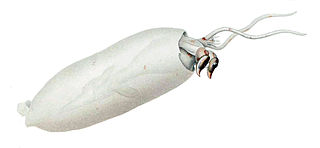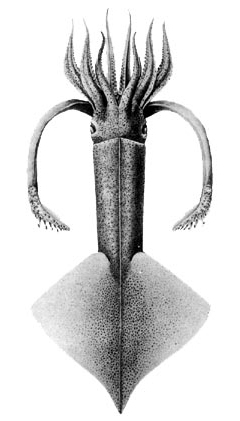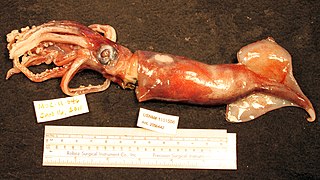
Ancistrocheirus lesueurii, the sharpear enope squid, is the only species in the genus Ancistrocheirus and family Ancistrocheiridae. With a mantle length of 25 cm (9.8 in), this moderately sized squid may be found throughout the tropical and subtropical oceans. They tend to be found at mesopelagic depths.

Joubiniteuthis portieri, also known as Joubin's squid from the monotypic family Joubiniteuthidae and genus Joubiniteuthis. It is a rare, small squid which occurs in the mesopelagic to bathypelagic zones and which has a worldwide distribution in tropical and subtropical regions. It is a distinctive squid having long arms I-III which have numerous small suckers in six rows. Its biology is little known. It is thought that it stays in the depths of the ocean with its arms outstretched, waiting for small animals to ensnare after they have accidentally swum into the arms. This species is named after Louis Joubin, a French zoologist. It is known to reach a mantle length of 9 cm (3.5 in).

The Mastigoteuthidae, also known as whip-lash squid, are a family of small deep-sea squid. Approximately 20 known species in six genera are represented, with members found in both the mesopelagic and bathypelagic zone of most oceans. Originally described by Verill in 1881, it was later lowered by Chun (1920) to a subfamily (Mastigoteuthinae) of the Chiroteuthidae. However, Roper et al. (1969) raised it back to the family level, and this has not been changed since. The taxonomy of this family is extremely unstable, and there have been at times one genus, two genera and four subgenera(Salcedo-Vargas & Okutani, 1994), two genera and several 'groups', five genera and one species with an uncertain placement, or six genera.
Liguriella is a genus of glass squids, the genus is probably monotypic, the only species being Liguriella podophthalma. The other named species Liguriella pardus, which was described by S. Stillman Berry in 1916, is cited as a taxon inquirendum but it is suggested that there may be in fact more than one species and there are species yet to be described.

Bathothauma lyromma, the lyre cranch squid, is a highly modified species of glass squid from the family Cranchiidae with a distribution which encompasses most of the world's oceans from the tropics to high latitudes.

Sandalops melancholicus, the sandal-eyed squid or melancholy cranch squid, is a small species of glass squid. It is known to reach a mantle length of 11 cm (4.3 in). It is distributed in the tropical and subtropical oceans around the world. It is the only species in the genus Sandalops but some authorities suggest that this may be a species complex rather than a monotypic genus.

Histioteuthis reversa, commonly known as the reverse jewel squid or the elongate jewel squid, is a species of cock-eyed squid, so called because the eyes are dissimilar. It occurs at moderate depths in the Atlantic Ocean and the Mediterranean Sea. It is also known from the Indian Ocean.

Onychoteuthis is a genus of squid in the family Onychoteuthidae. The type species is Onychoteuthis bergii. While the genus is found worldwide in tropical and subtropical oceans, they can also occur in the North Pacific Ocean. There were previously considered to be four species in the genus but there are now considered to be roughly 10. These squid are frequently observed in the surface waters at night and they are often caught using dipnet at nightlight stations. The young squid are usually the only specimens captured using standard midwater trawls, the older squid are apparently able to avoid the trawls. They can, however be collected from the air as individuals are able to leap high out of the water, sometimes even landing on the deck of a ship.

The neon flying squid, sometimes called the red flying squid, akaika, and red squid is a species of large flying squid in the family Ommastrephidae. They are found in subtropical and temperate oceanic waters globally.

Illex coindetii, commonly known as the southern shortfin squid or broadtail shortfin squid, is a species of neritic squids in the family Ommastrephidae. They are found in the Mediterranean Sea and on both sides of the north Atlantic Ocean.

Abralia veranyi is a species of squid in the family Enoploteuthidae. Common names include the eye-flash squid, Verany's enope squid and the midwater squid. It is found in the Atlantic Ocean and the Mediterranean Sea. It undergoes a daily vertical migration from deep waters to near the surface.
Sthenoteuthis pteropus, also known as the orangeback flying squid or orangeback squid, is a species of cephalopod in the family Ommastrephidae. It is native to tropical parts of the Atlantic Ocean where it is found to depths of about 200 m (656 ft).

Histioteuthis heteropsis, known as the strawberry squid, is a species of small cock-eyed squid. The scientific nomenclature of these squid stems from their set of differently sized eyes, one being small and blue and the other being large and yellow. It is thought that the large eye is used to see objects against dim light, while the smaller eye is more able to view bioluminescent light sources. The squid's vernacular name arose due to its rich red skin pigmentation and the presence of photophores along its body, making it appear like a strawberry with seeds.

Taonius belone is a glass squid belonging to the genus Taonius from the family Cranchiidae. It occurs in the northern subtropical and in the tropical or equatorial waters of the Pacific Ocean and the Indian Ocean.
Lampadioteuthis megaleia is a small, colorful squid, the only species in the only genus in the monotypic family Lampadioteuthidae. It is sometimes known as the wonderful firefly squid. It was formerly classified in the family Lycoteuthidae, but differs from them mainly by having a hectocotylus in the males and by the possession of a rostrum on the gladius.
Nematolampas regalis, the regal firefly squid is a small, little-known species of squid from the family Lycoteuthidae which is found in the subtropical South Pacific Ocean. This squid has a mantle length of 30 mm (1.2 in). It may be sexually dimorphic, with the males possibly having very thin elongated arms III, which are increasingly thread like towards their tips, where they do not have any suckers. Arms II are "normal" and have suckers along their length. The third arms have a series of photophores along their length, and there is a small photophore located on each of the tips of arms I and II. The tentacles have two embedded photophores and the largest of the eye's photophores is in the centre. There is a pair of large photophores close to the tip of the mantle on the ventral side mantle, with no other photophores on the body except for a visceral photophore which is also near the tip. There is practically no tail.
Eucleoteuthis is a monotypic genus of squid from the family Ommastrephidae; the only species is Eucleoteuthis luminosa, the striped flying squid or luminous flying squid.

Ornithoteuthis antillarum, the Atlantic bird squid, is a species of flying squid from the family Ommastrephidae which is found in the warmer waters of the Atlantic Ocean. This species is an important component of the diet of many species of fish and of cetaceans. It is taken as a bycatch in fisheries but has the potential to be commercially important if appropriate fishing methods can be developed.
Ornithoteuthis volatilis, the shiny bird squid, is a squid from the subfamily Ommastrephinae, the flying squids, of the family Ommastrephidae part of the pelagic squid order Oegopsida. It is a tropical and sub-tropical species which is widely distributed in the Indo-Pacific oceans. It is slightly larger than the closely related species Ornithoteuthis antillarum of the Atlantic Ocean.
Histioteuthis meleagroteuthis is a species of small to medium squids that have a dark, wine-red skin pigment. Females at maturity average at 114 mm (4.5 in) in length, while males at maturity average at 65 to 102 mm in length. This species is characterized by tubercles, photophores, and asymmetric features. This species can be found in circumglobal, mesopelagic waters.













